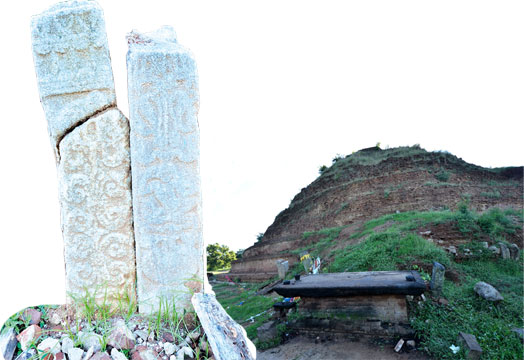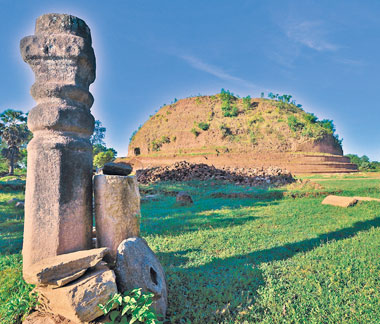|
Deegavapi:
A place that resonates spirituality
Story and pictures by Mahil Wijesinghe
|

The sacred Deegavapi Stupa as seen today |
We set off early, literally chasing the dawn, as we drove along the
carpeted A-25 highway. Our destination was the Deegavapi Raja Maha
Viharaya. Deegavapi itself has been subjected to much controversy when a
dynamic politician and an equally dynamic monk were still alive. Well,
that was a murky blip in the fascinating history of a place that dates
back to the time of the Buddha and is much revered place of worship.
Anyway, speeding along the highway, we turned left from Siyabalanduwa
towards Ampara, even as the dawn shaded the landscape in fascinating
hews of pink and yellow and morning mist. Our route took us past paddy
fields and sugar plantations until we reached Irakkamam town. Deegavapi
is 12 kilometres from Irakkamam town, past the panoramic vista of
Irakkamam Wewa and several water bodies that are the life blood of the
adjacent paddy fields. A visual bonus was the peacocks literally
performing the 'sun worship dance' from their tree top perches.
Deegavapi has always been a place of veneration for Buddhists. It is
said that the Buddha during his second visit to Sri Lanka accepted the
invitation of the Naga King, Maniakkitha, and made a third visit to the
country. According to legend, the Buddha proceeded to Deegavapi after
placing an imprint of his foot on a gem stone at the summit of Sri Pada
or Adam's Peak.
The Deegavapi Stupa that we see today is located at the place where
the Buddha and his entourage of 500 monks rested and the Stupa is one of
the 16 sacred sites (Solosmasthana) visited by him. It is said that the
Buddha, fulfilling a request made by the Gods, gifted a fingernail relic
to be placed within the Stupa, which was named Naka Vihara, giving
further significance to the temple.
Naka Vihara
The name Deegavapi means 'long tank', which many have identified with
the Irakkamam tank located just a few kilometres from the Stupa. The
present Deegavapi Stupa, located at a place called Veerydi, was
originally referred to as Naka Vihara. Given the history, size and close
proximity to the tank, many have accepted this to be the place where the
Deegavapi Stupa was originally built.
|

Scattered stone ruins with beautifully carved motifs |
Human settlements in ancient Sri Lanka began after the arrival of
Prince Vijaya. The first settlements were established in Anuradhapura
and later spread to the East. The name Deegavapi came to existence when
Prince Digayu, brother of Prince Vijaya's Indian wife Baddakachchayana
gave priority to establishing settlements in his name along the banks of
Gal Oya in Digamadulla. In order to develop agriculture, building tanks
for irrigation was priority during this time. Accordingly, an elongated
tank - Deega Wewa - which translates into Deegavapi was constructed near
Naka Vihara. This gives rise to the belief that Naka Vihara was
originally known as Deegavapi Vihara.
History records that during the time of Prince Saddha Tissa (137-119
BC), much agriculture based development was seen in Digamadulla,
ensuring further development of the Deega Wewa. It is believed that it
was during this development that the massive structure of the Deegavapi
Stupa came to be erected at this hallowed spot. The Deegavapi Viharaya
was a significant place of worship during this period with many monks in
residence. King Saddha Tissa's time can be seen as a period where the
Deegavapi temple played an important role in the spread of Buddhism to
the Eastern part of the country.
Neglected and claimed by the jungle overgrowth prior to the
construction of the Gal Oya Dam in Inginiyagala, this sanctified spot
was actually discovered as Deegavapi in 1925.
Sacred site
The area has now been declared a sacred site and although the Stupa
would have been imposing edifice, what have been restored today are the
remains of the original masterpiece. Restoration work on the Deegavapi
Stupa began 1965, with the Department of Archaeology and the Gal Oya
Development Board carrying out the work with the help of public
supported Shramadana campaigns.
 Scattered
around the Stupa are numerous ruins including elaborately carved stone
pillars with beautiful motifs, moonstones, flower altar and stone
inscriptions. One of the restored artefacts is a Vahalkada sculpture
with disfigured elephant heads carved on quartz. On the western side of
the Stupa are depictions of Goddess Lakshmi seated upon the Kalpa-Wuksa,
carved on stone pillar erected near one of the Vahalkada sculptures. On
either side are two elephants sprinkling water over her, in what is
believed to be a symbol of fertility. Scattered
around the Stupa are numerous ruins including elaborately carved stone
pillars with beautiful motifs, moonstones, flower altar and stone
inscriptions. One of the restored artefacts is a Vahalkada sculpture
with disfigured elephant heads carved on quartz. On the western side of
the Stupa are depictions of Goddess Lakshmi seated upon the Kalpa-Wuksa,
carved on stone pillar erected near one of the Vahalkada sculptures. On
either side are two elephants sprinkling water over her, in what is
believed to be a symbol of fertility.
Today, what remains of the ancient temple is only the massive ruin of
the Deegavapi Stupa, with only a portion of the base restored by the
Department of Archaeology. Although the original base of the Stupa
remains intact, what remains of the Stupa itself is a pile of rubble
lying by the side in an ungainly heap. Alongside the Stupa however, is a
large quantity of modern day bricks, indications of a plant to start
restoration work sometime in the near future.
The new shrine room Budu Gaya and the spacious pilgrims' rest are
newly added structures to the temple. After recent archaeological
excavations in and around the Deegavapi Stupa, many artefacts have been
found at the site including precious jewels, golden Buddha statues,
coins, all of which have been preserved and are on display at the
archaeological museum located in the temple premises. |

